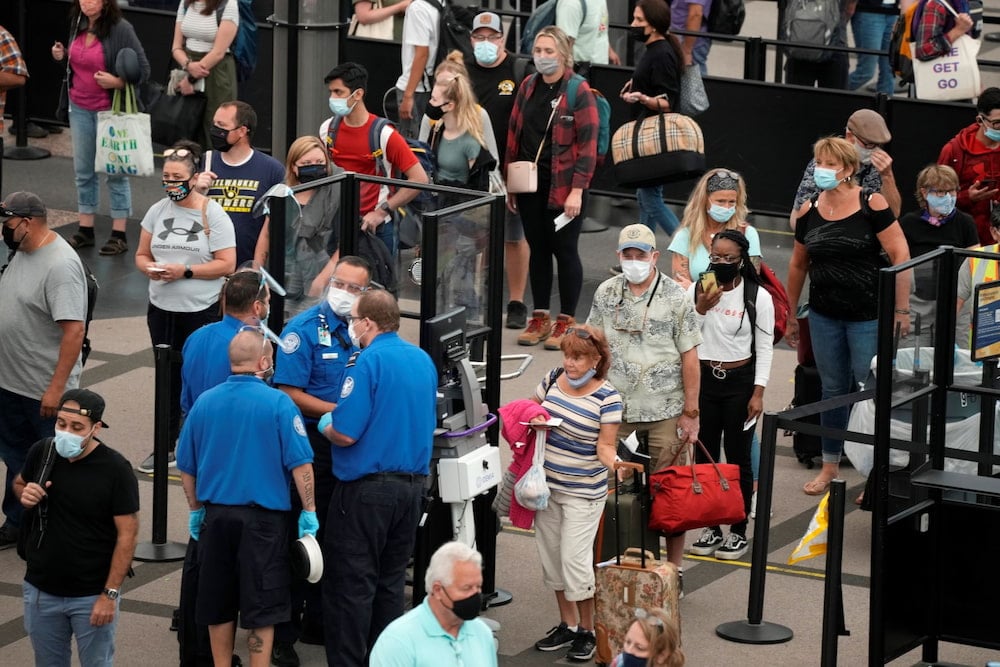Ask anyone old enough to remember travel before September 11, 2001, and you’re likely to get a gauzy recollection of what flying was like.
There was security screening, but it wasn’t anywhere near as intrusive. There were no long checkpoint lines. Passengers and their families could walk right to the gate together.
That all ended when four hijacked planes crashed into the World Trade Centre towers, the Pentagon and a field in Pennsylvania.
The worst terror attack on American soil led to increased and sometimes tension-filled security measures in airports across the world.
The cataclysm has also contributed to other changes large and small that have reshaped the airline industry – and, for consumers, made air travel more stressful than ever.
Two months after the attacks, President George W. Bush signed legislation creating the Transportation Security Administration (TSA) , which required that all checked bags be screened, cockpit doors be reinforced, and more federal air marshals be put on flights.
There has not been another 9/11. Nothing even close. But after that day, flying changed forever.
Security measures evolved with new threats, and so travellers were asked to take off belts and remove some items from bags for scanning. Things that clearly could be wielded as weapons, like the box-cutters used by the 9/11 hijackers, were banned.
After “shoe bomber” Richard Reid’s attempt to take down a flight from Paris to Miami in late 2001, footwear started coming off at security checkpoints.
To many travellers, other rules were more mystifying, such as limits on liquids because the wrong ones could possibly be used to concoct a bomb.
“It’s a much bigger hassle than it was before 9/11 – much bigger – but we have gotten used to it,” Ronald Briggs said as he and his wife, Jeanne, waited at Dallas/Fort Worth International Airport for a flight to London recently.
The long lines created by post-attack measures gave rise to the PreCheck and Global Entry “trusted-traveller programs” in which people who pay a fee and provide certain information about themselves pass through checkpoints without removing shoes and jackets or taking laptops out of their bag.
But that convenience has come at a cost: privacy.
PreCheck asks people about basic information like work history and where they have lived, and they give a fingerprint and agree to a criminal-records check.
Privacy advocates are particularly concerned about ideas that TSA has floated to also examine social media postings (the agency’s top official says that has been dropped), press reports about people, location data and information from data brokers including how applicants spend their money.
“It’s far from clear that that has any relationship to aviation security,” says Jay Stanley, a privacy expert at the American Civil Liberties Union.
More than 10 million people have enrolled in PreCheck. TSA wants to raise that to 25 million, with the goal of allowing officers to spend more time on passengers considered to be a bigger risk.
At the direction of Congress, the TSA will expand the use of private vendors to gather information from PreCheck applicants. It currently uses a company called Idemia, and aims to add two more – Telos Identity Management Solutions and Clear Secure Inc.
Clear plans to use PreCheck enrollment to boost membership in its own identity-verification product by bundling the two offerings. That will make Clear’s own product more valuable to its customers, which include sports stadiums and concert promoters.
“They are really trying to increase their market share by collecting quite a lot of very sensitive data on as many people as they can get their hands on,” says India McKinney, director of federal affairs for the Electronic Frontier Foundation, an advocacy group for digital rights.
TSA Administrator David Pekoske, though, sees Clear’s strategy as helping TSA: “We have allowed the vendors to bundle their offerings together with the idea that would be an incentive for people to sign up for the trusted-traveller programs.”
The TSA is testing the use of kiosks equipped with facial-recognition technology to check photo IDs and boarding passes. The kiosks will also pull photos taken when the traveller applied for PreCheck, McKinney says. That concerns her because it would mean connecting the kiosks to the internet – TSA says that much is true – and potentially exposing the information to hackers.
Despite the trauma that led to its creation, and the intense desire to avoid another 9/11, the TSA itself has frequently been the subject of questions about its methods, ideas and effectiveness.
Critics, including former TSA officers, have derided the agency as “security theatre” that gives a false impression of safeguarding the travelling public. Pekoske dismisses that notion by pointing to the huge number of guns seized at airport checkpoints – more than 3200 last year, 83 per cent of them loaded – instead of making it onto planes.
Pekoske also ticked off other TSA tasks, including vetting passengers, screening checked bags with 3-D technology, inspecting cargo and putting federal air marshals on flights.
“Rest assured: This is not security theatre,” Pekoske says. “It’s real security.”
This summer, an average of nearly 2 million people per day have flowed through TSA checkpoints.
With all the different ways that deadly chaos could happen on airplanes after 9/11, the fact remains: Most of the time, it hasn’t. And while the post-9/11 global airport security apparatus has grown to what some consider unreasonable proportions, it will never neutralise all threats – or even be able to enforce the rules it has written.
“You can’t catch everything,” says Nathan Dudney, a sales executive for a sporting goods manufacturer in Nashville who says he occasionally forgets about ammunition in his carry-on bag. “They’re doing things to the best of their ability.”
AAP
Get all the latest Canberra news, sport, entertainment, lifestyle, competitions and more delivered straight to your inbox with the Canberra Daily Daily Newsletter. Sign up here.



